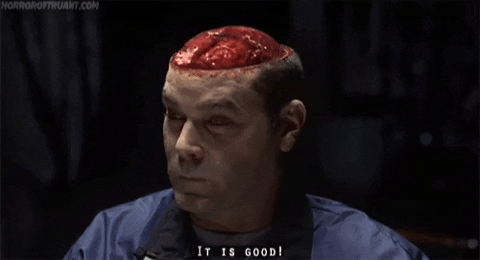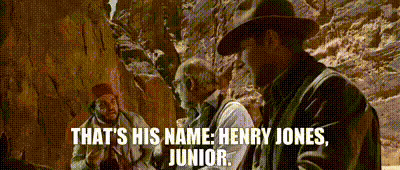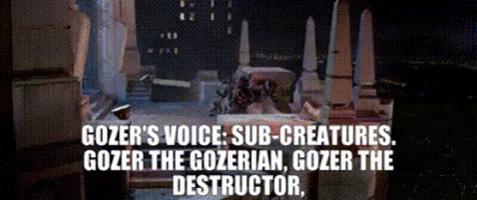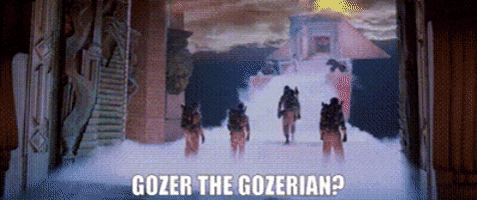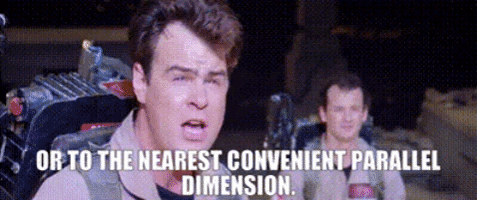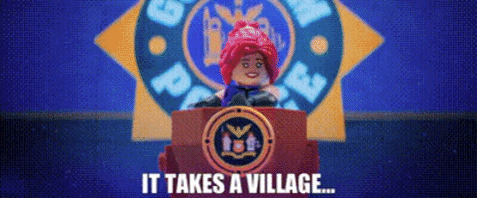
This word,
"Villain"
Do you know where it comes from?
C'est francais.
It means, originally,
"One Who Lives in a Village."
A Peasant.
Do I seem like a peasant to you?
village (n.)
late 14c., "inhabited place larger than a hamlet but smaller than a town," from Old French vilage "houses and other buildings in a group" (usually smaller than a town), from Latin villaticum "farmstead" (with outbuildings), noun use of neuter singular of villaticus "having to do with a farmstead or villa," from villa "country house" (from PIE root *weik- (1) "clan"). As an adjective from 1580s.
Village idiot is recorded from 1825.
Related: Villager (1560s).
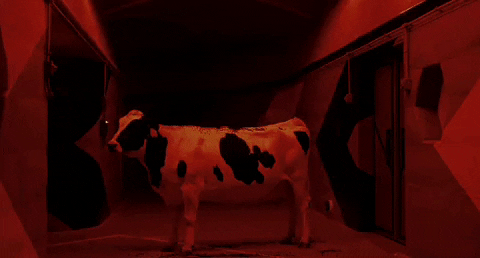
*weik- (1)
Proto-Indo-European root meaning "clan, social unit above the household."
It forms all or part of: antoecian; bailiwick; Brunswick; diocese; ecology; economy; ecumenical; metic; nasty; parish; parochial; vicinage; vicinity; viking; villa; village; villain; villanelle; -ville; villein; Warwickshire; wick (n.2) "dairy farm."
[FAROUK CHUCKLES SOFTLY.]
This word, "Villain"
Do you know where it comes from?
C'est francais.
It means, originally,
"One Who Lives in a Village."
A peasant.
Do I seem like a peasant to you...?
You know what I mean.
No.
This is important.
Language.
The meaning of things.
You called me a Villain.
Me, the king.
[SPEAKING PERSIAN.]
For decades I rule over my country.
I'm a good king.
Strong but just.
My people, they prosper.
And then your father a white man, which is –
You tell me, important...?
He comes.
Does he speak our language?
Does he know our customs?
And he decides what?
That my people should have better.
That he knows better.
Who is he to make such choices?
LEGION :
[SETS GLASS DOWN.]
You fed off me when I was a baby.
And I'm supposed to feel, what, sorry for you?
FAROUK:
Is it such a terrible thing?
To feel sorrow for your enemy? What is he, except a brother with another name?
LEGION :
We're not brothers.
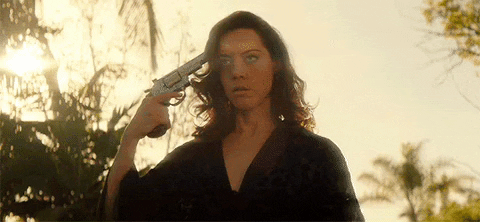
[POPS.]
[WATER BURBLING.]
FAROUK:
You are still young.
You think justice is a glass jar.
You fill it with your hurt, your hate.
Don't you think I have my own jar? I'm a refugee.
Do you know the meaning of that word? Refugee.
Driven from my home, in exile.
Prisoner in another man's body.
LEGION :
Nobody put you in my head.
Or Oliver's.
You made a choice.
FAROUK :
[CHUCKLES.]
: Of course.
If the choice is between death or life I choose life.
LEGION :
Listen, I'll call you when I have the monk somewhere safe.
He takes us to your body, and then you are gone.
Gone.
No one ever hears your name again.
FAROUK :
Interesting, don't you think?
You're doing this for a woman you love who lives in a future you're going to destroy if you help me.
LEGION :
What do you mean?
FAROUK :
The timeline.
She lives in a future you are trying to change, and when you do, she will cease to exist.
So really you are helping her to commit suicide.
Oh, and be careful with the monk.
He is very [SPEAKS GERMAN.]
Contagious.
See, this, uh [TEETH CHATTERING.] madness.
They think it's me, that I'm infecting people.
But it's him.
He's Toxic.
He is like Typhoid Mary.
But where he goes, I follow.
So your friends think that I am the Mary.
Not so smart, your friends.
JOSEPH CAMPBELL:
I’ve been to Le Moustier, that was one of the earliest burial caves that were found.
BILL MOYERS: And you find there what they buried with the dead?
JOSEPH CAMPBELL:
Yes. These grave burials with grave gear, that is to say weapons and sacrifices round about, certainly suggest the idea of the continued life beyond the visible one.
The first one that was discovered, the person was put down resting as though asleep, a young boy, with a beautiful hand ax beside him.
Now, at the same time we have evidence of shrines devoted to animals that have been killed.
The shrines specifically are in the Alps, very high caves, and they are of cave bear skulls.
And there is one very interesting one with the long bones of the cave bear in the cave bear’s jaw.
BILL MOYERS:
What does that say to you?
JOSEPH CAMPBELL:
Burials.
“My friend has died and he survives.’
The animals that I’ve killed must also survive. I must make some kind of atonement relationship to them.”
The indication is of the notion of a plane of being that’s behind the visible plane, and which is somehow supportive of the visible one to which we have to relate.
I would say that’s the basic theme of all mythology.
BILL MOYERS:
That there is a world?
JOSEPH CAMPBELL:
That there is an invisible plane supporting the visible one.
Now, whether it is thought of as a world or simply as energy, that differs from time and time and place to place.
BILL MOYERS:
What we don’t know supports what we do know.
JOSEPH CAMPBELL:
That’s right.
The basic hunting myth, I would say, is of a kind of covenant between the animal world and the human world, where the animal gives its life willingly.
They are regarded generally as willing victims, with the understanding that their life, which transcends their physical entity, will be returned to the soil or to the mother through some ritual of restoration.
And the principal rituals, for instance, and the principal divinities are associated with the main hunting animal, the animal who is the master animal, and sends the flocks to be killed, you know.
To the Indians of the American plains, it was the buffalo.
You go to the northwest coast, it’s the salmon.
The great festivals have to do with the run of salmon coming in. When you go to South Africa, the eland, the big, magnificent antelope, is the principal animal to the Bushmen, for example.
BILL MOYERS:
And the principal animal, the master animal
JOSEPH CAMPBELL:
Is the one that furnishes the food.
BILL MOYERS:
So there grew up between human beings and animals, a bonding, as you say, which required one to be consumed by the other.
JOSEPH CAMPBELL:
That’s the way life is.
BILL MOYERS:
Do you think this troubled early man, too
JOSEPH CAMPBELL:
Absolutely, that’s why you have the rites, because it did trouble him.
BILL MOYERS:
What kind of rites?
JOSEPH CAMPBELL:
Rituals of appeasement to the animals, of thanks to the animal.
A very interesting aspect here is the identity of The Hunter with The Animal.
BILL MOYERS:
You mean, after the animal has been shot.
JOSEPH CAMPBELL:
After the animal has been killed, the hunter then has to fulfill certain rites in a kind of “participation mystique,” a mystic participation with the animals whose death he has brought about, and whose meat is to become his life.
So the killing is not simply slaughter, at any rate, it’s a ritual act.
It’s a recognition of your dependency and of the voluntary giving of this food to you by the animal who has given it.
It’s a beautiful thing, and it turns life into a mythological experience.
BILL MOYERS:
The hunt becomes what?
JOSEPH CAMPBELL:
It becomes a ritual.
The hunt is a ritual.
BILL MOYERS:
Expressing a hope of resurrection, that the animal was food and you needed the animal to return.
JOSEPH CAMPBELL:
And some kind of respect for the animal that was killed; that’s the thing that gets me all the time in this hunting ceremonial system.
BILL MOYERS:
Respect for the animal.
JOSEPH CAMPBELL:
The respect for the animal and more than respect, I mean, that animal becomes a messenger of divine power, do you see.
BILL MOYERS:
And you wind up as the hunter killing the messenger.
JOSEPH CAMPBELL:
Killing the god.
BILL MOYERS:
What does this do?
Does it cause guilt, does it cause
JOSEPH CAMPBELL:
Guilt is what is wiped out by the myth.
It is not a personal act; you are performing the work of nature, For example, in Japan, in Hokkaido in northern Japan among the Ainu people, whose principal mountain deity is the bear, when it is killed there is a ceremony of feeding the bear a feast of its own flesh, as though he were present, and he is present.
He’s served his own meat for dinner, and there’s a conversation between the mountain god, the bear and the people.
They say, “If you’ll give us the privilege of entertaining you again, we’ll give you the privilege of another bear sacrifice. ”
BILL MOYERS: If the cave bear were not appeased, the animals wouldn’t appear, and these primitive hunters would starve to death. So they began to perceive some kind of power on which they were dependent, greater than their own.
JOSEPH CAMPBELL: And that’s the power of the animal master. Now, when we sit down to a meal, we thank God, you know, or our idea of God, for having given us this. These people thanked the animal.
BILL MOYERS: And is this the first evidence we have of an act of worshipó
JOSEPH CAMPBELL:
Yes.
BILL MOYERS:
— of power superior to man?
JOSEPH CAMPBELL:
Yeah.
BILL MOYERS:
And the animal was superior,
because the animal provided food.
JOSEPH CAMPBELL:
Well, now, in contrast to our relationship to animals, where we see animals as a lower form of life, and in the Bible we’re told, you know, we’re the masters and so forth, early hunting people don’t have that relationship to the animal. The animal is in many ways superior, He has powers that the human being doesn’t have.
BILL MOYERS:
And then certain animals take on a persona, don’t they
the buffalo, the raven, the eagle.
JOSEPH CAMPBELL:
Oh, very strongly.
Well, I was up on the northwest coast back in 1932,
a wonderful trip, and the Indians along the way were still carving totem poles.
The villages had new totem poles, still.
And there we saw the ravens and we saw the eagles and we saw the animals that played roles in the myths.
And they had the character, the quality, of these animals.
It was a very intimate knowledge and friendly, neighborly,
relationship to these creatures.
And then they killed some of the. You see.
The animal had something to do with the shaping of the myths of those people, just as the buffalo for the Indians of the plains played an enormous role. They are the ones that bring the tobacco gift, the mystical pipe and all this kind of thing, it comes from a buffalo. And when the animal becomes the giver of ritual and so forth, they do ask the animal for advice, and the animal becomes the model for how to live.
BILL MOYERS:
You remember the story of the buffalo’s wife?
JOSEPH CAMPBELL:
That’s a basic legend of the Blackfoot tribe, and is the origin legend of their buffalo dance rituals, by which they invoke the cooperation of the animals in this play of life.
When you realize the size of some of these tribal groups, to feed them required a good deal of meat. And one way of acquiring meat for the winter would be to drive a buffalo herd, to stampede it over a rock cliff. Well, this story is of a Blackfoot tribe long, long ago, and they couldn’t get the buffalo to go over the cliff. The buffalo would approach the cliff and then tum aside. So it looked as though they weren’t going to have any meat for that winter.
Well, the daughter of one of the houses, getting up early in the morning to draw the water for the family and so forth, looks up and there right above the cliff were the buffalo. And she said, “Oh, if you’d only come over, I’d marry one of you.” And to her surprise, they all began coming over. That was surprise number one. Surprise number two was when one of the old buffalos, the shaman of the herd, comes and says, “All right, girlie, off we go.” “Oh, no,” she says. “Oh, yes,” he says, “you made your promise. We’ve kept our side of the bargain, look at all my relatives here dead. Off we go.”
Well, the family gets up in the morning and they look around, and where’s Minnehaha, you know. The father, and you know how Indians are, he looked around and he said, “She’s run off with a buffalo.” He could see by the footsteps. So he says, “Well. I’m going to get her back.” So he puts on his walking moccasins, bow and arrow and so forth, and goes out over the plains. He’s gone quite a distance when he feels he’d better sit down and rest, and he comes to a place that’s called a buffalo wallow, where the buffalo like to come and roll around, get the lice off, and roll around in the mud.
So he sits down there and is thinking what he should do now, when along comes a magpie. Now, that’s a beautiful, flashing bird, and it’s one of those clever birds that has shamanic qualities.
BILL MOYERS:
Magical qualities.
JOSEPH CAMPBELL:
Magical. And the man says to him, “Oh, beautiful bird, my daughter ran away with a buffalo. Have you seen, will you hunt around and see if you can find her out on the plain somewhere?” And the magpie says, “Well, there’s a lovely girl with the buffalos right now, over there just a bit away.” “Well,” said the man, “would you go tell her that her daddy’s here, her father’s here at the buffalo wallow?” Magpie flies over and the girl is there among the buffalo; they’re all asleep. I don’t know what she’s doing, knitting or something of the kind. And the magpie comes over close to her and he says, “Your father’s over at the wallow waiting for you.” “Oh,” she says, “this is very terrible, this is dangerous, I mean, these buffalo, they’ll kill us. You tell him to wait, I’ll be over, I’ll try to work this out.”
So her buffalo husband’s behind her and he wakes up and takes off a horn, he says, “Go to the wallow and get me drink.” So she takes the horn and goes over and there’s her father. And he grabs her by the arm and he says, “Come.” She says, No, no, no, this is real dangerous. The whole herd there, they’ll be right after us. I have to work this thing out, now let me just go back.” So she gets the water and goes back and he, “Fe, Fi, Fo, Fum, I smell the blood of an Indian.” You know, that sort of thing. And she says, “No, nothing of the kind.” And he says, “Yes, indeed.” So he gives a buffalo bellow and they all get up and they all do a slow buffalo dance with their tails raised, and they go over and they trample that poor man to death, so that he disappears entirely, he’s just all broken up to pieces, all gone.
The girl’s crying, and her buffalo husband says, “So you’re crying.” “This is my daddy.” He said, “Yeah, but what about us? There are children, our wives, our parents, and you crying about your daddy.” Well, apparently he was a kind of sympathetic compassionate buffalo, and he said, “Well, I’ll tell you, if you can bring your daddy back to life again, I’ll let you go.” So she turns to the magpie and says, “See, peck around a little bit and see if you can find a bit of Daddy.” And the magpie does so, and he comes up finally with a vertebra, just one little bone.
And the little girl says, “That’s plenty. Now, we’ll put this down on the ground,” and she puts her blanket over it, and she sings a revivifying song, a magical song with great power. And presently, yes, there’s a man under the blanket. She looks, Daddy all right, but he’s not breathing yet. A few more stanzas of whatever the song was, and he stands up, and the buffalo are amazed. And they say, “Why don’t you do this for us? We’ll teach you now our buffalo dance, and when you will have killed our families, you do this dance and sing this song, and we’ll all be back to life again.”
That’s the basic idea, that through the ritual, that dimension is struck which transcends temporality and out of which life comes and back into which it goes.
BILL MOYERS:
And it goes back to this whole idea of death, burial and resurrection, not only for human beings, but for…
JOSEPH CAMPBELL:
But for the animals, too.
BILL MOYERS:
So the story of the buffalo’s wife was told to confirm the reverence.
JOSEPH CAMPBELL: That’s right.
BILL MOYERS: What happened when the white man came and slaughtered this animal of reverence?
JOSEPH CAMPBELL: That was a sacramental violation. I mean, in the eighties, when the buffalo hunt was undertaken, you know, with Kit Carson…
BILL MOYERS: The 1880s, a hundred years ago.
JOSEPH CAMPBELL: — and Buffalo Bill and so forth. When I was a boy, whenever we went for sleigh rides we had a buffalo robe. Buffalo, buffalo, buffalo robes all over the place. This was the sacred animal to the Indians. These hunters go out with repeating rifles, and then shoot down the whole herd and leave it there. Take the skin to sell and the body’s left to rot. This is a sacrilege, and it really is a sacrilege.
BILL MOYERS: It turned the buffalo from a “thou-”
JOSEPH CAMPBELL: To an “it.”
BILL MOYERS: The Indians addressed the buffalo as “thou.”
JOSEPH CAMPBELL: As a “thou”.
BILL MOYERS: As an object of reverence.
JOSEPH CAMPBELL:
The Indians addressed life as a “thou,” I mean, trees and stones, everything else. You can address anything as a “thou”, and you can feel the change in your psychology as you do it. The ego that sees a “thou” is not the same ego that sees an “it.” Your whole psychology changes when you address things as an “it.” And when you go to war with a people, the problem of the newspapers is to turn those people into its, so that they’re not “thous.”
BILL MOYERS:
That was an incredible moment in the evolution of American society, when the buffalo were slaughtered.
That was the final exclamation point behind the destruction of the Indian civilization, because you were destroying…
JOSEPH CAMPBELL:
Can you imagine what the experience must have been for a people within 10 years to lose their environment, to lose their food supply, to lose the object of the… the central object of their ritual life?



